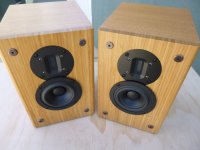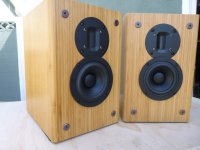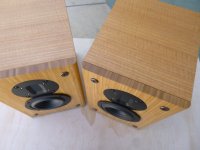Hello,
I am (finally) building my small desktop speakers using the 5" T-B W5-2143 drivers I was given. Is it acceptable/wise to use solid hardwood for the baffle boards for very small boxes like this? I am using Baltic Birch plywood for the rest of the box, but would like to add a bit of splash to them by using Padauk or other richly coloured hardwood for the fronts rather than just more Baltic Birch...
Thank you in advance for your guidance.
Joe
I am (finally) building my small desktop speakers using the 5" T-B W5-2143 drivers I was given. Is it acceptable/wise to use solid hardwood for the baffle boards for very small boxes like this? I am using Baltic Birch plywood for the rest of the box, but would like to add a bit of splash to them by using Padauk or other richly coloured hardwood for the fronts rather than just more Baltic Birch...
Thank you in advance for your guidance.
Joe
Yes, it's fine.
If you can't sleep because someone said that hardwood isn't the best choice for speaker cabinets, you can always add a layer of some other material, or use braces to support the hardwood and avoid vibrations (like here). However, I am pretty sure no one will be able to hear a difference between the hardwood and something else.
If you can't sleep because someone said that hardwood isn't the best choice for speaker cabinets, you can always add a layer of some other material, or use braces to support the hardwood and avoid vibrations (like here). However, I am pretty sure no one will be able to hear a difference between the hardwood and something else.
Just be careful trying to glue up oily exotics like padouk to plywood, use acetone to clean the edges before glue is applied, and use some bracing to reinforce the edge. I used padouk on some small desktop enclosures and found that one needed to use a rabbet other than a butt joint to spread out the surface are for adequate glue adhesion. First box didn't hold very well with just a butt joint, and the second one held very well with the rabbet and a couple small strips along the inside of each joint.
Thank you both for your responses. I will indeed brace the front panels, and also wipe all the glue-up surfaces with solvent to remove any natural oils before assembly. I plan to use West System epoxy rather than regular wood glue, mostly due to the long working time, since I am pathetically slow at getting things aligned fast enough...
I will post pictures of them when they are done.
Thanks!
Joe H.
I will post pictures of them when they are done.
Thanks!
Joe H.
Ply is stable hence a great choice for cabinets, solid hardwoods are not. Be mindful that even over a relatively small distance hardwood will expand and contract across the grain due to the seasons. This movement will put a lot of stress on the glue used. You could veneer front and back a piece of thinner plywood (creating desired thickness) with your chosen hardwood. Ideally your veneers. Veneers can be ripped on a band saw and should be 1-3mm with the ply being thicker (bulk). You must do both sides if you do this as again even veneers expand/contract so need to be balanced on both sides.
This will eventually cause the joint to self distruct.
In my experience, this statement is either "aggressive" or incorrect.
I have built 40+ cabinets with 9" wide solid lumber baffles glued to MDF. My kit customers have built 300+ (estimated) with no reported failures using 9" wide lumber glued to MDF. Some folks may have used quarter-sawn , but not many.
I am also aware that Mr. Short formerly of North Creek Music recommended a similar method but with tile adhesive between the baffle and primary MDF cabinet.
I ain't sayin' the poster above is completely and emphatically wrong. I will still allow that minor stress cracks may happen. I will also allow that a kitchen chair subject to growing boys would destroy many glue joints over time. I will also allow that Norh loudspeakers initial wood drum cabinet designs were large and certainly cracked. I will also that subjecting lumber to seasonal humidity extremes will cause stress.
I was worried about this too.
My very crude analysis is that guys trying to glue lumber cross-grain had statistically significant problems at 11-12+" width during seasonal moisture changes.
Gluing a relatively narrow solid lumber baffle - go for it !
I fully understand why commercial folks use MDF. It is extremely stable, but... I would easily and happily use solid lumber in my home.
Recent Work
Most recently:
Most recently:
An externally hosted image should be here but it was not working when we last tested it.
Same photo
I think I discovered how to get the photo to display correctly - via google photo's. Hopefully this works.
I think I discovered how to get the photo to display correctly - via google photo's. Hopefully this works.
An externally hosted image should be here but it was not working when we last tested it.
Why epoxy for wood to wood?
A few reasons why it can be good (I'm sure Paul can give us others):
1.) Long working time
2.) Structural gap filling; wood glue makes an incredibly strong bond in tight joints but is not strong unto itself. If you have loose joints, mixing epoxy with glass beads or even sawdust to make a putty can give you a strong joint.
3.) Better adhesion to oily woods (still use the acetone right before gluing)
You are correct the joint will be under continuous stress because of the ebb&flow movement of solid wood. This will eventually cause the joint to self distruct.
That was my first concern--making a airtight box that allows for the wood movement of solid wood. At 6.75" wide, you're not going to get a ton of movement but quite possibly enough. Maybe Joe, our OP, could possibly mount a 1/2" solid baffle using a flexible glue to a second plywood piece and only join the latter to the walls? That way it could float above the box. Eg the following ascii art of a corner joint
|
|
|__________ ... Plywood to plywood corner joint
___________ ... Padauk mounted with flexible glue covering the corner joint
- Status
- This old topic is closed. If you want to reopen this topic, contact a moderator using the "Report Post" button.
- Home
- Loudspeakers
- Full Range
- Solid hardwood front panel ok?


